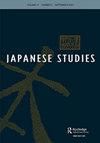Sawako Nakayasu Eats Sagawa Chika: Translation, Poetry, and (Post)Modernism
IF 0.4
Q3 AREA STUDIES
引用次数: 0
Abstract
ABSTRACT This article examines the works of modernist poet Sagawa Chika (1911–1936) and her translator Sawako Nakayasu (b.1975), analyzing how they both intersect translation and creation, problematizing issues of gender. Sawako Nakayasu’s Mouth: Eats color (2011) is a collection mixing English, Japanese, French, and Spanish ‘translations, anti-translations, and originals’, which have as a starting point Sagawa Chika’s poems. I first discuss Sagawa’s work translating writers such as James Joyce, Charles Reznikoff, and others, focusing on the way in which she develops a unique poetic vocabulary through translation, setting her apart within the (male-centered) modernist movement. Next, I analyze the way Nakayasu approaches Sagawa’s texts when rendering them into English, making the translation process visible and positioning some of the results as nijisōsaku (spin-offs), or ‘transcreations’. My analysis of the above-mentioned texts will shed light on translation, self-translation, and anti-translation as methods through which the woman poet-translator explores unique ways of being and writing in the world. Special attention will be paid to translation as anthropophagy from the margins, that is, as a process of consuming and metabolizing central discourses, sometimes beyond recognition.佐川千香:翻译、诗歌和(后)现代主义
摘要本文考察了现代主义诗人佐川千香(1911-1936)和她的翻译家中谷泽子(b.1975)的作品,分析了他们如何将翻译和创作交叉起来,将性别问题化。Sawako Nakayasu的《嘴巴:吃颜色》(2011)是一本融合了英语、日语、法语和西班牙语“翻译、反翻译和原作”的合集,以佐川千香的诗歌为起点。我首先讨论佐川翻译詹姆斯·乔伊斯、查尔斯·雷兹尼科夫等作家的工作,重点是她通过翻译发展独特的诗歌词汇的方式,使她在(以男性为中心的)现代主义运动中脱颖而出。接下来,我分析了Nakayasu在将佐川的文本翻译成英语时处理这些文本的方式,使翻译过程可见,并将一些结果定位为nijisōsaku(衍生产品)或“转录”。我对上述文本的分析将揭示翻译、自译和反译作为女性诗人译者探索世界上独特存在和写作方式的方法。翻译将被特别关注为边缘的人类吞噬,即一个消耗和代谢中心话语的过程,有时甚至面目全非。
本文章由计算机程序翻译,如有差异,请以英文原文为准。
求助全文
约1分钟内获得全文
求助全文

 求助内容:
求助内容: 应助结果提醒方式:
应助结果提醒方式:


